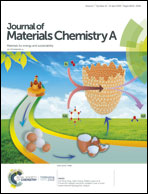A novel composite strategy to build a sub-zero temperature stable anode for sodium-ion batteries†
Abstract
The extended application of sodium ion batteries (SIBs) to cold climates or high-altitude areas has been severely impeded by the sluggish solid-diffusion process of Na+ in the anode material. Herein, we for the first time report CoGa2S4 as a novel anode material for SIBs, exhibiting superior full cell performance when coupled with a high-voltage Na0.7[Mn0.6Ni0.2Mg0.2]O2 (NMN-2) cathode in a voltage range of 1.0–4.1 V. More importantly, when tested at an ultra-low temperature of −60 °C, CoGa2S4 delivers a high reversible capacity close to 100 mA h g−1 upon 1000 cycles at a current density of 1 A g−1. This excellent low-temperature performance is attributed to the fact that after the first discharge process of the CoGa2S4 electrode, the Ga-based sulfide loses its electrochemical reaction activity, but fortunately it can serve as a high ionic conductivity medium, facilitating the conversion reaction of cobalt sulfides. The phenomenon that the Ga-based sulfide in CoGa2S4 sacrifices the capacity, but allows cobalt sulfides to withstand temperature variation sheds light on designing high performance sub-zero temperature anodes for SIBs.

- This article is part of the themed collection: 2019 Journal of Materials Chemistry A HOT Papers


 Please wait while we load your content...
Please wait while we load your content...